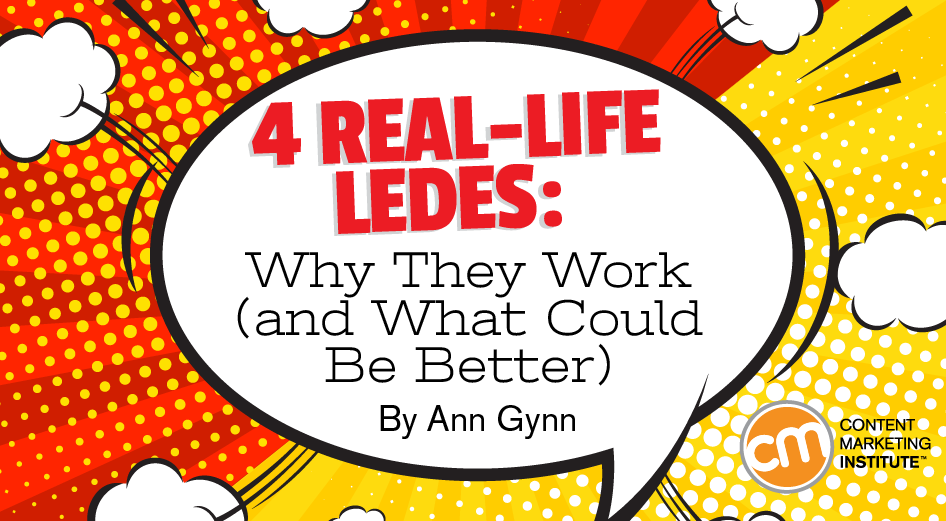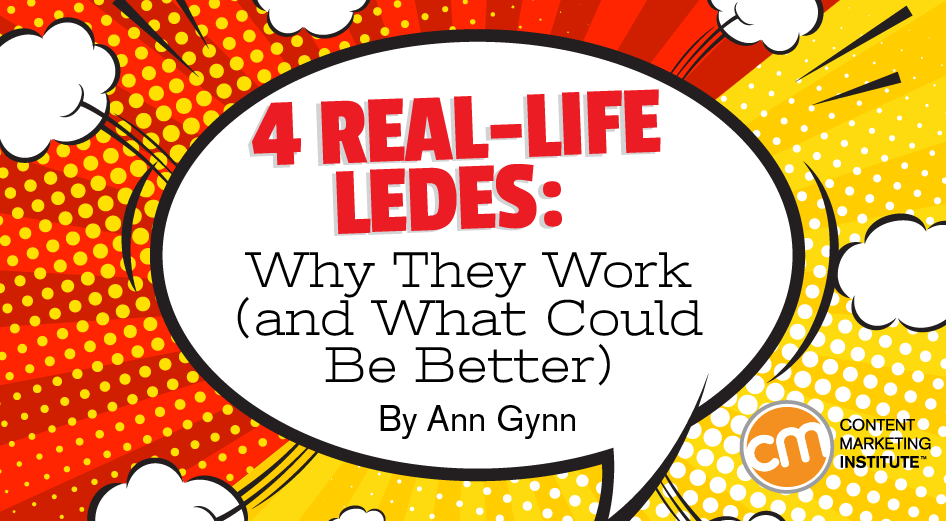You may be surprised at how much better you can make your lede if there’s a word count stop sign. What works (in the buried lede): Speaks directly to the reader (the use of “you”) Indicates the writer knows the reader – someone who is into fitness but has other priorities that make maximizing their workout time important Sets the expectation this article will provide an answer Focuses on the topic (cardio exercise equipment) unlike the original lede, which mentions swimming Tips to make it better: Make every word count. It’s 24 words. Her training plan called for her to run a 10K event a few weeks before. Though this narrative lede is good, it could have been even more powerful if the headline didn’t reveal the whole story – It Took a Heart Attack to Reveal a Heart Disorder. What if it were written like this: No need for a revised lede – it works well as is. Don’t forget suspense Incorporating a curiosity factor, as Andrew Davis said at Content Marketing World, really captures your audience. Writing an engaging story (no matter how long it is) requires an ending that connects to the start. Greatness requires fitting together all those pieces to create a smooth, enticing, relevant, and timely experience for your readers. Start your content marketing story off right in 2019.

OK, the original plan for this article was to provide great examples of ledes in B2B and B2C content marketing.
But a funny thing happened in that search – mediocre ledes dominated.
That’s disappointing because, next to the headline, the lede is everything. It’s the determining factor on whether to read the article. The lede has many responsibilities – to hook the reader, to indicate the subject matter, to set the article tone, etc.
Since mediocre and less-than-middling ledes abound, let’s focus on a few that show what works and what doesn’t. Then, discover tips and ideas on how to create great ledes.
Note: I use the journalistic form “lede,” which is “the introductory section of a news story to entice the reader to read the full story.” Technically, “lead” is also correct.
Set the scene
The Glassdoor blog offers a range of topics relevant to its visitors, who come to find jobs, read peer reviews of workplaces, and get career advice such as this piece with its good-not-great lede:
How Taking a Sabbatical Can Boost Your Career
After spending too many late nights at the office, who among us hasn’t fantasized from time to time about leaving all of our responsibilities behind and heading to some far-off location — perhaps the white-sand beaches of Mexico, the rugged mountains of Switzerland or the stunning traditional architecture of Japan. But inevitably, reality sets in: You’ve got work to do, chores to finish and a steady drumbeat of bills, loans and expenses to pay.
What if that fantasy didn’t have to remain a fantasy, though? What if there were a way you could take off months, or even a year or more, and come back reenergized and ready to take on the corporate world, with a healthy bank account to boot?

What works
- Sets an attractive scene – white-sand beaches, rugged mountains, stunning architecture (and uses three diverse locations to attract readers with different travel interests)
- Shows an understanding of the audience by including their challenge (late nights at office) and their aspiration (leaving responsibilities behind for a far-off location)
- Takes reader on thought trip in the first paragraph:
- Oh yes, I spend too much time working.
- Wow, it would be cool to get rid of those responsibilities, especially if I get to take a dream trip.
- But, I can’t because I’ve got to earn money to pay for things.
Tips to make it better
- Paint the picture with fewer strokes (i.e., words). Pretend your content platform limits the number of words or characters – and won’t let you publish unless your text falls at or below its mandatory count. You may be surprised at how much better you can make your lede if there’s a word count stop sign. FYI – mobile screens average 80 to 100 words before a reader must scroll – that’s too long for a lede but it’s helpful to keep in mind as you structure the introduction.
- Don’t ask obvious questions. If you’re writing a what-if or other question that elicits the same response from every reader, delete it. Use declarative or definitive statements instead and fulfill that promise in the article.
What if it were written like this:
After spending too many late nights at the office, you fantasize about leaving your responsibilities and heading to some far-off location — the white-sand beaches of Mexico, the rugged mountains of Switzerland, or the stunning architecture of Japan.
It doesn’t have to be a fantasy.
The revised lede is 44 words (the original was 120). I removed the paragraph with several questions because the opening paragraph sufficiently sets the aspirational scene. It also delivers the article’s purpose more quickly.
Recognize your audience
The MyFitnessPal blog serves a community built around the company’s app, which people use to track meals and physical activity. The nicely designed blog offers lots of good content, including this stairclimber-or-treadmill article.
What’s a Better Workout: Stairclimber or Treadmill?
Whether you’re a fan of lacing up your sneakers for a walk or like to swim laps at the pool, there’s no denying it’s important to get a regular dose of cardio. Not only does it help to burn fat and assist with weight management, but it also has other science-backed benefits, like improved mental clarity and preventing muscle loss.
The lede doesn’t work on multiple levels. And yet, the writer wrote a better lede – it was just buried a few paragraphs down:
… Sometimes when you’re in a rush, fitting in the suggested 150 minutes of moderate exercise every week gets shoved to the backburner. That’s where popular pieces of cardio equipment come in — specifically two of the biggest calorie-burners: the treadmill (on an incline) and the stairclimber.

What works (in the buried lede):
- Speaks directly to the reader (the use of “you”)
- Indicates the writer knows the reader –…

COMMENTS